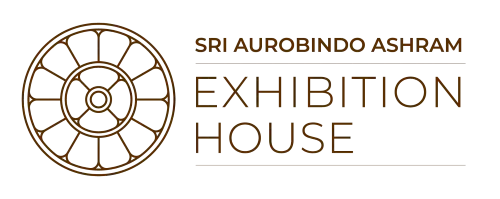The Mother at the Embroidery Exhibition, 1956
Exhibition House was inaugurated by the Mother in February 1956, opening with an exhibition of textiles and embroidery, followed by a photography exhibition in August. Exhibition House was established to exhibit all forms of art and is meant to be a space that reflects beauty through various creative expressions. In The National Value of Art, Sri Aurobindo states that “music, art and poetry are a perfect education for the soul; they make and keep its movements purified, self-controlled, deep and harmonious” and adds: “They are, when properly used, great educating, edifying and civilising forces.” Art, then, is a means for the education of the soul. It is also a way of expressing, through beauty, the Divine Ananda of creation. And finally art is a part of the renaissance of India, the awakening and revival of her national spirit.
Artist : The Mother
1. Education of the Soul
The Mother found parallels between Art and Yoga, “The discipline of Art has at its centre the same principle as the discipline of Yoga. In both the aim is to become more and more conscious; in both you have to learn to see and feel something beyond the ordinary vision and feeling, to go within and bring out from there deeper things.”
Art, then, can be a part of one’s spiritual life and a help in finding one’s soul. Art can be a means of refining one’s being, purifying its movements, deepening its emotions, harmonizing its parts. Through diverse exhibitions and art appreciation workshops, we intend to explore different genres of art throughout history, to see how they help in the education of the soul.
2. Art, Beauty and Ananda
“Art is a thing of beauty,” Sri Aurobindo observed,” and beauty and Ananda are closely connected – they go together.” Beauty is the governing factor for us at Exhibition House. In our exhibitions and workshops we hope to trace the many forms of beauty that have been manifested through the ages, connecting different histories and knowledge systems. We are planning a series of curated exhibitions based on different aesthetic theories (from both the East and West) as well as the writings of Sri Aurobindo and the Mother.
The Mother says “True art means the expression of beauty in the material world. In a world wholly converted, that is to say, expressing integrally the divine reality, art must serve as the revealer and teacher of this divine beauty of life.”
Artist : Hu Hsu
Artist : Hu Hsu
2. Art, Beauty and Ananda
“Art is a thing of beauty,” Sri Aurobindo observed,”and beauty and Ananda are closely connected – they go together.” Beauty is the governing factor for us at Exhibition House. In our exhibitions and workshops we hope to trace the many forms of beauty that have been manifested through the ages, connecting different histories and knowledge systems. We are planning a series of curated exhibitions based on different aesthetic theories (from both the East and West) as well as the writings of Sri Aurobindo and the Mother.
The Mother says “True art means the expression of beauty in the material world. In a world wholly converted, that is to say, expressing integrally the divine reality, art must serve as the revealer and teacher of this divine beauty of life.”
Artist : Krishnalal
3. Awakening of Indian Spirit
In an essay on the renaissance in India written in 1918, Sri Aurobindo mentions three steps of development, “The first step was the reception of the European contact….The second was the reaction of the Indian spirit upon the European influence….The third, only now beginning or recently begun, is rather a process of new creation in which the spiritual power of the Indian mind remains supreme….”
He then cited “the new Indian art as a striking example” of this process of new creation, an “urgent and original creation” in consonance with India’s spirit. In our forthcoming exhibitions, we will present many new forms of Indian art, connecting the old and the new in a synthesis. These exhibitions will be supported by appropriate background texts to provide a historical perspective.
